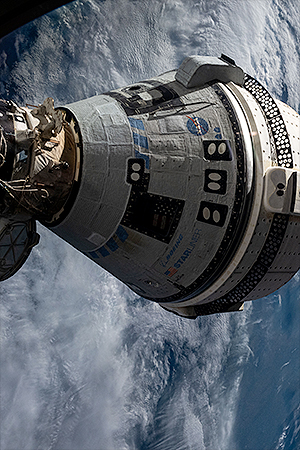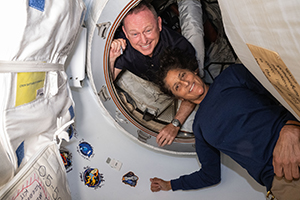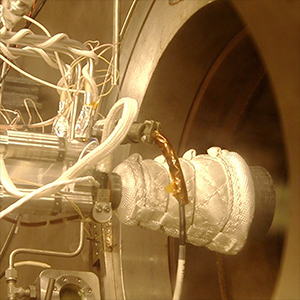 advertisements advertisements
|

|
Boeing Starliner to land uncrewed, astronauts to return with SpaceX
August 24, 2024 — Astronauts Barry "Butch" Wilmore and Sunita "Suni" Williams will not return to Earth aboard the Boeing spacecraft they flew into orbit, following a decision by NASA based on safety concerns.
Space agency officials on Saturday (Aug. 24) opted to land the CST-100 Starliner capsule "Calypso" without its crew after the new commercial vehicle encountered unexpected thruster issues on its way to the International Space Station in June. Since then, NASA and Boeing have been working together to perform tests both in space and on the ground to better understand why the Stariner's reaction control system (RCS) jets experienced failures.
"NASA has decided that Butch and Suni will return with [SpaceX's] Crew-9 next February and that Starliner will return uncrewed," said Bill Nelson, NASA Administrator, in a press conference at the agency's Johnson Space Center in Houston. "A test flight, by nature, is neither safe, nor routine. The decision to keep Butch and Suni aboard the International Space Station and bring Boeing's Starliner home uncrewed is the result of our commitment to safety: our core value and our North Star."
"I'm grateful to the NASA and Boeing teams for all their incredible and detailed work," said Nelson.
Wilmore and Williams launched on Boeing's first Starliner Crew Flight Test (CFT) on what the company and NASA had announced as an eight-day mission to the station. On the way to the orbiting laboratory, four of Starliner's RCS thrusters failed and had to be recovered to successfully achieve the docking at the station. Boeing's engineers later traced the issue back to the jets overheating when fired for extended amounts of time.
The same thrusters are needed for Starliner to undock and depart from the space station, as well as maintain orientation as the capsule's co-housed orbital maneuvering and attitude control (OMAC) engines perform the de-orbit burn that will bring Starliner back to Earth for a parachute- and airbag-assisted touchdown at the White Sands Missile Range in New Mexico.
"For me, one of the really important factors is that we just don't know how much we can use the thrusters on the way back home before we encounter a problem because of the heating effects that happened on the way uphill," said Ken Bowersox, NASA's Associate Administrator for Space Operations and a former astronaut. "That's what the team has been working so hard on these last couple of months."
"When we polled today all of the senior management of the different organizations that are involved with human spaceflight, they all concurred that we should have the crew come down on a different vehicle," said Bowersox. "We believe that Starliner coming back uncrewed, although higher than the risk we'd be willing to take to put crew on it, is a reasonable thing to do to finish the test flight and gather the data that we want to gather."
Starliner was designed to fly autonomously and earlier completed two uncrewed test flights. NASA and Boeing will work together to set up Starliner for its landing in the coming weeks. The vehicle must return to Earth before Crew-9 launches to ensure a docking port is available on the station.
The Crew-9 mission, which originally was slated to lift off with four crew members, will now launch with only two astronauts no earlier than Sept. 24. NASA has not yet announced who will remain on the crew from the assigned complement of U.S. astronauts Zena Cardman, Nick Hague and Stephanie Wilson, as well as Russian cosmonaut Aleksandr Gorbunov.
SpaceX is working on several items needed before the Crew-9 launch, including reconfiguring seats aboard the spacecraft and adjusting the manifest to carry additional cargo, personal effects and Dragon-compatible spacesuits for Wilmore and Williams.
Wilmore and Williams are both experienced astronauts with two previous spaceflights each. With their ride home now scheduled for February, each will add eight months to their previous 178 and 322 days (respectively) spent in space prior to this mission. During their extended stay, they will continue serving as part of the station's Expedition 71 and Expedition 72 crews.
"[Wilmore and Williams] support the agency's decision fully and they're ready to continue this mission on board the International Space Station," said Norm Knight, NASA's director of flight operations.
Nelson said that he spoke with Boeing's CEO Kelly Ortberg, who said that the company is committed to flying Starliner. When asked how confident he was that astronauts would fly again on the Boeing spacecraft, Nelson said, "100 percent." |
|

Boeing's Starliner spacecraft, which launched astronauts Butch Wilmore and Suni Williams to the International Space Station, is seen from the window of a SpaceX Dragon in July 2024. (NASA)

Astronauts Butch Wilmore and Suni Williams pose for a portrait inside the vestibule between the forward port on the International Space Station and Boeing's Starliner spacecraft. (NASA)

A Starliner Reaction Control System (RCS) thruster is put through one of the most stressing firing sequences at the White Sands Test Facility in New Mexico (NASA) |

Two members of Crew-9 will give up their seats on SpaceX's Dragon spacecraft in order to return Boeing's Starliner Crew Flight Test astronauts Butch Wilmore and Suni Williams to Earth in February 2025. Crew-9, as originally assigned and pictured, included Russian cosmonaut Aleksandr Gorbunov and U.S. astronauts Nick Hague, Zena Cardman and Stephanie Wilson (NASA) |
|

© 1999-2025 collectSPACE. All rights reserved.
|
|

|

|
